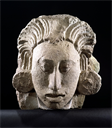Description
Maize was sacred for the Maya, whose livelihood depended on its successful cultivation. Every effort, both physical and ritual, was made to ensure conditions favorable for its production. A symbol of fruitfulness and prosperity, maize was often commemorated in art in the form of a beautiful young man. This head of personified maize was originally part of a figure carved in the round from the waist up. It represents maize as a well-proportioned youth with a long profile, close-set eyes, a soft facial contour, and an elongated and flattened forehead. He wears large earspools, and his long hair is combed back away from his face, suggesting maize leaves similar to the ones that once adorned the top of his head. A complete figure currently in the British Museum shows him richly adorned with jewelry and gesturing with his hands. He embodies the Maya ideal of grace and beauty, which Maya elites sought to emulate in their own portraits and in life, through such practices as cranial flattening to mimic the shape of a corn cob, dental modification, and the use of sumptuous attire and courtly manners.
This figure once ornamented the upper façade of a temple at Copan. Built by the city’s thirteenth ruler, Waxaklajun Ub’ah K’awil (who reigned 695-738), the temple embodied the generative aspects of the world. A chamber inside it was the symbolic center of the Maya cosmos. Around it, the exterior of the building was decorated with masks of the earth monster, representing the animated earth. At the top of the temple, maize figures sprouted out of the animated earth, possibly symbolizing the result of rituals performed within, and promising fertility, productivity, and abundance to the city’s population.
Bibliography
Benson, Elizabeth P. 1963 Handbook of the Robert Woods Bliss Collection of Pre-Columbian Art. Dumbarton Oaks, Trustees for Harvard University, Washington, D.C., p. 11, cat. 48.
Bliss, Robert Woods 1957 Pre-Columbian Art: The Robert Woods Bliss Collection. Text and Critical Analyses by S. K. Lothrop, Joy Mahler and William F. Foshag. Phaidon, New York. p. 248, cat. 102, pl. LXII, fig. 16.
Bliss, Robert Woods 1959 Pre-Columbian Art: The Robert Woods Bliss Collection. 2nd ed. Text and Critical Analyses by S. K. Lothrop, Joy Mahler and William F. Foshag. Phaidon, London. p. 256, cat. 102, pl. LXII, fig. 16.
Bühl, Gudrun (ED.) 2008 Dumbarton Oaks: The Collections. Dumbarton Oaks Research Library and Collection, Washington, D.C., p. 212-213.
Gallenkamp, Charles 1985 Maya. The Riddle and Rediscovery of a Lost Civilization. 3rd rev. ed. Viking; Albuquerque Museum, New York. ill. 10.
Gendrop, Paul 1973 La Escultura Clásica En La Cuenca Del Río Motagua. In Artes De México, Año Xx, No. 167, Paul Gendrop, ed., pp. 41-60, 90-91. Artes de México, México. p. 46, 52, 91.
Jaques, Susan 2012 A Love for the Beautiful: Discovering America's Hidden Art Museums. Discovering America's Hidden Art Museums. GPP, Globe Pequot Press, Guilford. p. 5.
Masuda, Yoshio 1981 Kodai Amerika No Isan. Shinch?sha Kodai Bijutsukan ; 14. Kabushiki Kaisha Shinch?sha, Tokyo. pl. 42.
Nicholson, Irene 1967 Mexican and Central American Mythology. Hamlyn, London. p. 125.
Pasztory, Esther 1998 Pre-Columbian Art. Cambridge University Press, Cambridge, UK. p. 58-61, fig. 40.
Pillsbury, Joanne, Miriam Doutriaux, Reiko Ishihara-Brito and Alexandre Tokovinine (EDS.) 2012 Ancient Maya Art at Dumbarton Oaks. Pre-Columbian Art at Dumbarton Oaks, Number 4. Dumbarton Oaks Research Library and Collection, Washington, D.C., p. iii, 13, fig. 12, Cover.
Sodi, Demetrio 1980 Los Mayas: El Tiempo Capturado. Bancomer, Mexico, D.F., p. 127.
Related:
Proskouriakoff, Tatiana 1980 Maize-God: The Symbol of Symbols. Symbols: A Publication of the Peabody Museum and the Department of Anthropology, Harvard University Summer 1980:8-10.
Exhibition History
"Indigenous Art of the Americas", National Gallery of Art, Washington DC, April 1956 to July 1962.
"Lasting Impressions: Body Art in the Ancient Americas" , Dumbarton Oaks, Washington, DC, 10/1/2011 - 3/4/2012.
Acquisition History
Acquired by exchange from the Harvard Peabody Museum, Cambridge, Massachusetts,1953.
Robert Woods Bliss Collection of Pre-Columbian Art, Washington, DC, 1953-1962.
Dumbarton Oaks Research Library and Collection, Pre-Columbian Collection, Washington, DC.
